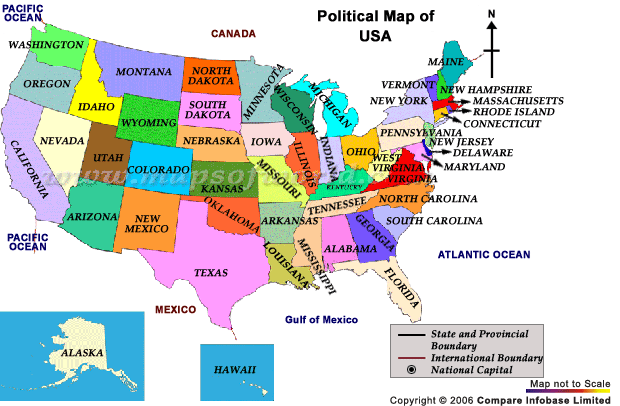Збірник завдань для підготовки учнів до ЗНО
Відділ освіти Куп’янської міської ради Харківської області
Куп’янський ліцей№5
Тема: США. Збірник завдань для підготовки учнів до ЗНО
Підготувала: Хабачкова Вікторія Іванівна,
учитель англійської мови,
спеціаліст вищої категорії,
«Старший учитель»
Куп’янськ - 2021
Пояснювальна записка
Збірник тестових завдань за темою «США» містить в собі цікавий матеріал країнознавчого характеру, що сприяє розширенню знань учнів з даної теми. Завдання складені за зразком ЗНО. Виконуючи їх учні готуються до випускних тестів, навчаються оглядовому та детальному читанню текстів, поглиблюють словниковий запас слів з даної теми.
Ілюстрації та фотографії, які супроводжують друкований матеріал викликають інтерес до даної інформації та розширюють знання соціокультурних особливостей країни, мова якої вивчається.
THE USA
Cities and towns
Read the texts below. Choose from (A-H) the one which best fits each space (1-7). There is a choice you don’t need to use
DEMOGRAPHIC CHANGES
The 1990 Census showed that some important demographic changes were taking place. Here are some results of the Census.
Re-ranking cities
|
1990 Census |
1980 Census |
|
1. New York City |
(1) |
|
2. Los Angeles |
(3) |
|
3. Chicago |
(2) |
|
4. Houston |
(5) |
|
5. Philadelphia |
(4) |
|
6. San Diego |
(8) |
|
7. Dallas |
(7) |
|
8. Phoenix |
(9) |
|
9. Detroit |
(6) |
|
10. San Antonio |
(11) |
The trend is clear. New York City remained the nation's largest — about 7 million, but the Census said it lost almost 40,000 residents.
Among the USA's next biggest — Los Angeles, _________1_________and Philadelphia — only the Sun Belt cities grew.
The USA's fastest growing city in the top 50 was Fresno, California, a farm town turned high tech. It grew by 61 % and has more than________2_______.
The Census figures show that the once sleeping giants of the South and West are the new power cities now. These figures also confirm the shift of the USA's money from the North and East. And they underscore the importance of Sun Belt cities seldom heard from 20 years ago, handing them more federal dollars, a larger voice in Washington and — even more than before — the power to sway presidential elections.
THE CITY OF WASHINGTON
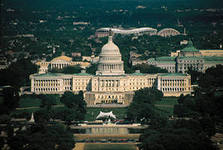
The city of Washington was designed in the________3_______. It is co-extensive with the District of Columbia. When George Washington was elected President of the United States, there was no permanent capital to house the government. Since members of Congress could not agree as to where the capital should be located, it was decided to choose a special place______4________. The State of Maryland agreed to allot a wild and marshy area on the Potomac River. The region was called the District of Columbia, ________5__________, and the capital was called Washington, after George. Washington.
Work on the new capital began in 1791. The man who designed the city was Major Pierre-Charles L'Enfant. His grand geometric plan envisioned stately buildings as the city's core and a grassy, park-like mall with uninterrupted vistas west from the Capitol Building to the Potomac River.
Yet, even by the turn of the twentieth century, Washington showed little of the grandeur of this vision. In the crowded area north of the Mall, factories and mills rubbed shoulders with stores__________6___________. The Mall itself had been broken into segments and landscaped with winding carriage roads and varied plantings that destroyed its symmetry. For a time the Mall was also a transportation center, with railroad tracks crossing at Sixth Street that created an eyesore and safety hazard.
In 1901, as citizens sought to beautify urban areas throughout the United States, the Senate Park Commission (commonly known as the McMillan Commission after its chairman, Senator James McMillan) developed an influential new plan for Washington. This plan aimed to return the city to the formality envisioned in the late eighteenth century and to invest it with a grandeur reflecting the nation's new sense of wealth and stature.
The Mall was to become a wide, ___________7_____________, against a backdrop of classical buildings, many with domes. At the foot of Capitol Hill, a "Union Square" was to be built with mounted statues of Civil War generals Grant, Sherman, and Sheridan, facing down the Mall.
The McMillam Commission had anticipated the need for a complex of government office building, and with the government's growth during World War I, the need was urgent by the 1920s. It was the financier and art collector Andrew Mellon (1855-1937) who soon became deeply involved in the city's architecture. As Secretary of Treasury, he was responsible for the realization of the so called Federal Triangular Project. The core of the project was to reconstruct the large triangular area north of the Mall between Constitution and Pennsylvania Avenues, from Sixth to Fifteenth Street and to build offices for the government.
To ensure that the project would reflect the dignity and importance of the Federal Government, Mellon established a "Board of Architectural Consultants", which ultimately included John Russell Pope, one of America's most prominent architects. Pope's contribution to the Federal Triangular Project was enormous. Thanks to Pope's plan, Washington today is among the most beautiful cities in the world.
A late eighteenth century
B formal lawn flanked by rows of trees
C the building was not finished
D 350,000 residents
E after Christopher Columbus
F hotels, restaurants, and row houses
G Chicago, Houston
H for the new capital
SEEING THE SIGHTS OF WASHINGTON
Read the texts below. For questions (1-8) choose the correct answer (A, B, C, D).
The Capitol
Located on Capitol Hill, the seat of American legislature dominates the City of Washington. Through the halls of this magnificent structure have passed the leading figures in American history.
The Capitol is the tallest edifice in_____1____: no other building is allowed to be taller than the Capitol. It stands 88 feet ____2___the level of the Potomac River and covers approximately 4 acres. Its length from north to south is 751 feet 4 inches; its width, including approaches, is 350 feet; and its height above the base line on the east front to the top of the Statue of Freedom is 287 feet 5 inches.
Construction of the US Capitol began in 1793. The original plan for the building was drawn by Dr. William Thornton. President John Adams addressed the first joint session of Congress in the Senate Chamber on November 22, 1800.
All interiors of the building were burned by the British in 1814. The Capitol was reoccupied in 1819. The present Senate and House wings were begun in 1851, but the building was not ____3_____until 1867. Since then, numerous changes have been made.
The Washington National Monument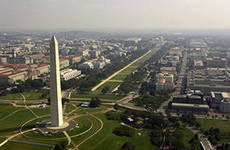
The Washington National Monument is a tapering shaft or obelisk of white marble, 555 feet five and one-eighth inches high.
In 1833 the Washington National Monument Society was organized "for the purpose of erecting a ____4_____National Memorial to Washington". Fifteen years later the cornerstone was laid.
After many difficulties and delays, the building was opened to the public in 1888. An elevator takes visitors to the 500-foot level. Return is by elevator as well but if one wishes, he can walk down the 898 steps, from which the 190 memorial stones donated by local, State, and foreign governments can be seen.
The Lincoln Memorial
In 1867, two years after Abraham Lincoln's death, Congress organized the Lincoln Memorial Association to plan _____5______to his memory.
Work finally started on February 12, 1914. Henry Bacon was the architect, and Daniel Chester French sculpted the great marble statue of Lincoln.
Carved on the walls are Lincoln's Gettysburg and Second Inaugural Addresses.
The Jefferson Memorial
Thomas Jefferson, besides being President of the United States, was also a gifted amateur architect, political thinker, and founder of the University of Virginia. This memorial, dedicated on April 13, 1943, the 200th anniversary of Jefferson's birth, was designed by the architectural firm of John Russell Pope in the simple classical style admired by Jefferson.
Inside the memorial is a 19-foot bronze statue of Jefferson sculpted by Rudulph Evans. Excerpts from four of Jefferson's writings are carved on the interior walls.
Surrounding the Memorial are cherry ____6_____that the City of Tokyo presented to the City of Washington in 1912.
The Arlington National Cemetery
Arlington National Cemetery was established on June 15, 1864, on land originally the estate of George Washington.
Prominent among the many memorials in this national cemetery is the Tomb of the Unknowns, and among the unknown dead are 2,111 who died on the battlefields in the Civil War.
Many famous Americans were buried here. On November 25, 1963, Arlington Cemetery became the burial _____7_____of John Fitzgerald Kennedy, President of the United States.
The Vietnam Veterans Memorial
The polished black granite walls are inscribed with the names of more than 58,000 men and ____8______who gave their lives or remain missing in the Vietnam War.
Names of the service men and women are inscribed "in the order they were taken from us". Alphabetical directories at the memorial help visitors find specific names by panel and line number.
A flag-staff and bronze statue of three servicemen stand at the entrance plaza.
|
1 |
A |
New York |
B |
Washington |
C |
Chicago |
D |
Houston |
|
2 |
A |
above |
B |
behind |
C |
about |
D |
of |
|
3 |
A |
ended |
B |
was over |
C |
finished |
D |
stopped |
|
4 |
A |
great |
B |
big |
C |
large |
D |
huge |
|
5 |
A |
a memorial |
B |
a portrait |
C |
a statue |
D |
a monument |
|
6 |
A |
bushes |
B |
trees |
C |
flowers |
D |
orchards |
|
7 |
A |
ground |
B |
land |
C |
soil |
D |
earth |
|
8 |
A |
children |
B |
parents |
C |
women |
D |
boys |
Read the text below. Choose from (A-H) the one which best fits each space (1-7). There is a choice you don’t need to use
NEW YORK
New York, N. Y., is the post office designation of the largest______1______. Officially it is the City of New York, and popularly it is called New York City.
The City of New York is situated at the mouth of_____2_______, sometimes called the North River. The five boroughs comprising the city are: Manhattan, on the Manhattan Island between the Hudson and East Rivers; the Bronx, on the southernmost part of the mainland; Queens and Brooklyn, on Long Island, separated from Manhattan by East River; and Richmond on Staten Island in New York Bay.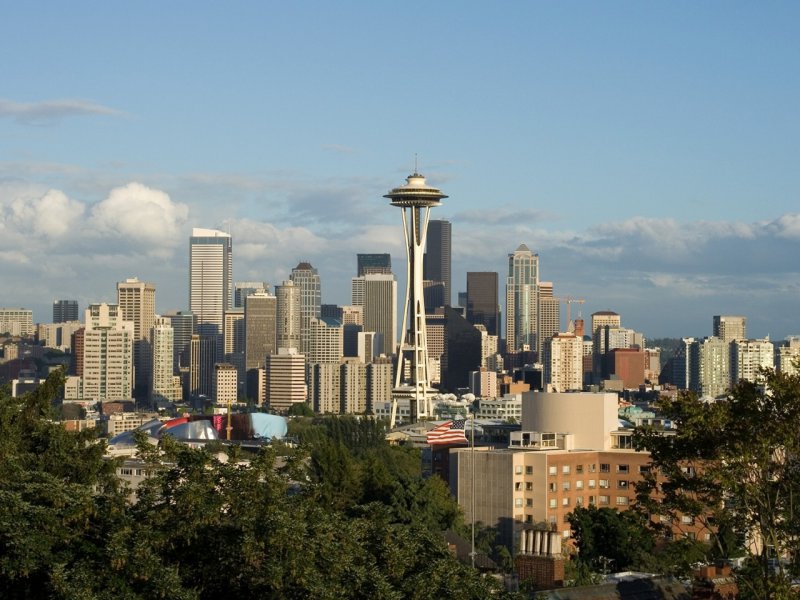 The City credits Verrazano as first viewing in 1524 the place, where New York now stands. Henry Hudson found Manhattan on September 11, 1609. The first houses ____3______in lower Manhattan in 1613. On May 6, 1626, Peter Minuit, director general of New Netherland, as the Dutch called the colony, paid the Indians 60 guilders for Manhattan, commonly translated as $24, actually $39.
The City credits Verrazano as first viewing in 1524 the place, where New York now stands. Henry Hudson found Manhattan on September 11, 1609. The first houses ____3______in lower Manhattan in 1613. On May 6, 1626, Peter Minuit, director general of New Netherland, as the Dutch called the colony, paid the Indians 60 guilders for Manhattan, commonly translated as $24, actually $39.
When the settlement had around 200 people,__________4____________.
In 1653 they erected a wall to protect their settlement from which Wall Street takes its name.
On September 8, 1664, British troops occupied New Amsterdam without resistance, overthrew the Dutch government, and called the place New York. Seven years later the Dutch recaptured the city and called it New Orange, but in 1674 the city was in the hands of the British again who returned the name New York.
The City of New York has always been in the center_______5_______. It witnessed the American Revolution; the Declaration of Independence was read to the American troops here on July 9, 1776, in the presence of George Washington.
It was here on April 30, 1789, that Washington took the oath of office on the balcony of Federal Hall. Thanks to its geographical position and historical past, New York has grown into a big financial, __________6_________with the heart in the Borough of Manhattan. America's business and culture are in Manhattan. The Empire State Building, the World Trade Center, Times Square, Rockefeller Center, Central Park, Harlem, Metropolitan Museum of Art, Broadway — all these World famous sights are in Manhattan. What unites them is probably a small street, only a few blocks long, which is the financial center of the whole United States — Wall Street. It provides the nation with centralized credit and banking facilities. It is a sales place for securities; it is also one of the biggest money capitals of the world. Economic and financial power of the United States is concentrated in the buildings______7________; in the Stock Exchange, one of the world's greatest; in the banks, among them the oldest in the city, the Bank of New York, founded in 1784.
A the Hudson River
B it was named New Amsterdam
C of Wall Street
D were built
E commercial, and industrial center
F the symbol of America's freedom,
G of political events
H metropolis in the United States
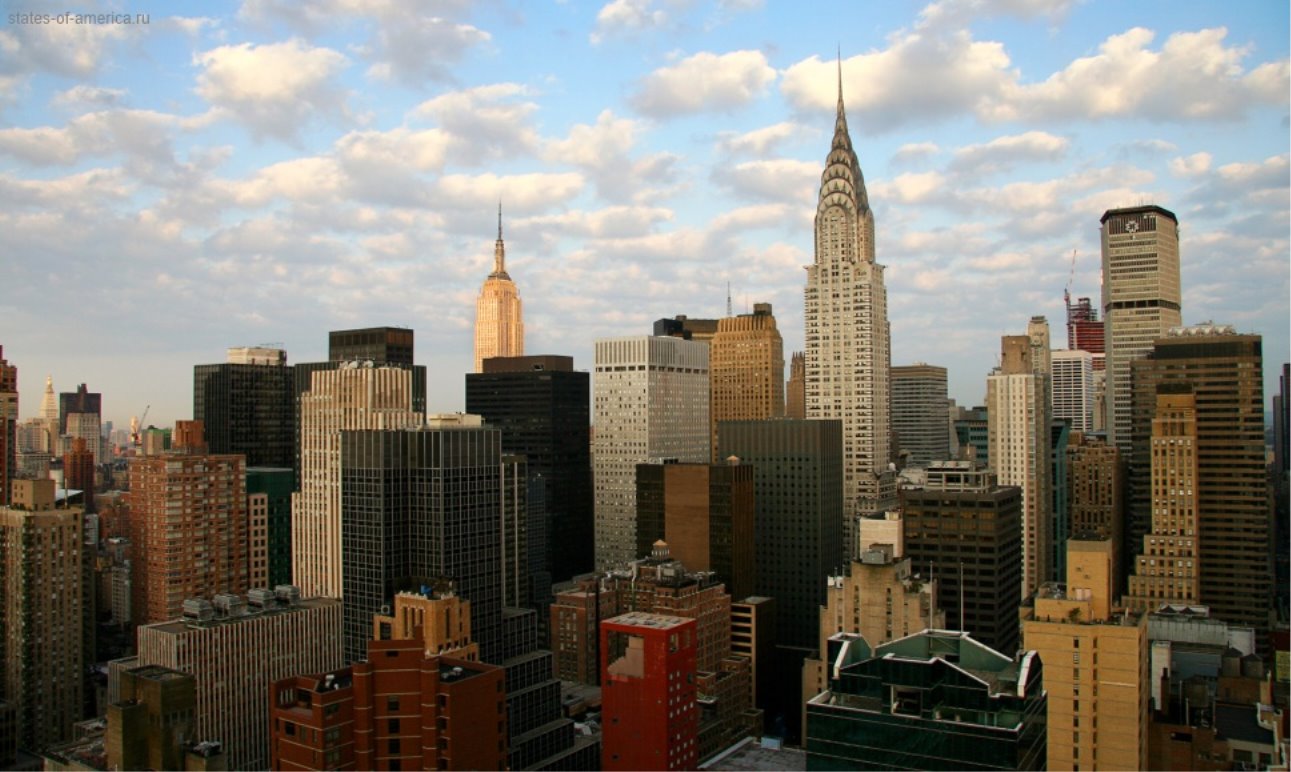
The symbols of USA
THE STATUE OF LIBERTY
Ever since 1886, ___1___her great torch was lifted into place 305 feet above Liberty Island in New York Harbor, the colossal statue of "Liberty Enlightening the World" has symbolized America for millions of eager newcomers. Many wept as they neared the American____2____, recalling all they had left behind and apprehensive about what they might find in the new land. But with their first glimpse of the statue, one Italian immigrant recalled, they were "steadied ... by the concreteness of the symbol of America's freedom, and they dried their tears".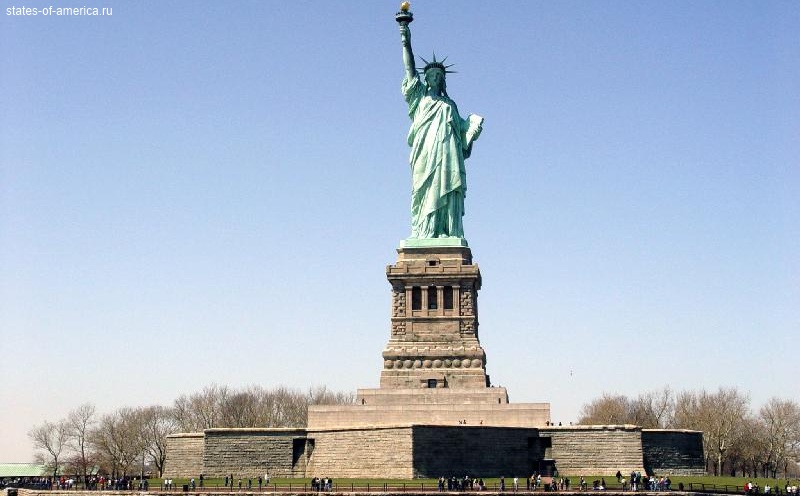
The statue was the work of Alsatian sculptor Frederic Auguste Bartholdi and was intended to commemorate both a century of amity between France and the United States and the concept of political freedom shared by the two nations.
The book that Liberty holds in her left hand symbolizes the Declaration of Independence. The main figure is attached to an iron framework designed by Gustave Eiffel, builder of France's Eiffel Tower.
The statue was paid for by French contributors; American schoolchildren participated in a nationwide drive to raise funds for the pedestal. On a tablet within are inscribed the last five lines of a sonnet, "The New Colossus", by Emma Lazarus, herself an immigrant:
Give me your tired, your poor, Your huddled masses yearning to breathe free, The wretched refuse of your teeming shore, Send these, the homeless, tempest-tost to me, I lift my lamp beside the golden door!
THE WHITE HOUSE
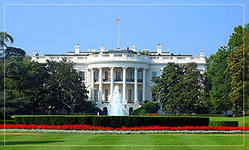
The White House, the official _____3____of the President, stands in tree-shaded grounds (18 acres) on the south side of Pennsylvania Avenue. The main building has 6 floors, with the East Terrace leading to the East Wing, a 3-story building used for offices and as an entrance for official events. The West Terrace contains offices and leads to the Executive Office.
The White House was designed by James Hoban, an Irish-born architect. President Washington chose the site which was included in the plan of the Federal City prepared by Major Pierre L'Enfant.
The cornerstone of the Executive Mansion, as it was originally known, was laid on October 13, 1792, 300 years after the landing of Columbus. President Washington was not present and never lived in the house. It was John Adams, the second President (1797-1801), who arrived in the new Capital City to take up his residence in the White House. On his second evening in its damp, unfinished rooms, he wrote to his wife, "Before I end my letter, I pray Heaven to bestow the best of Blessings on this House and all that shall hereafter inhabit it. May none but honest and wise Men ever rule under this roof.
The President's home was the earliest of all government buildings in the District of Columbia. Compared to the huge, glittering palaces used by European and Asian rulers at the time it was built, the ___4___House is a simple, almost unpretentious dwelling place.
On August 24, 1814, during Madison's administration (1809— 1817), the British troops entered Washington and set fire to the White House. By December 1817, James Hoban had completed rebuilding the Executive Mansion, and President Monroe (1817— 1825) moved in.
The British were indirectly responsible for the name "White House". Since the marks of the fire were clearly seen on the sandstone walls, they had to be obliterated by being painted white. But the house remained the "Executive Mansion" until the administration of Theodore Roosevelt (1901-1909), when the words "White House" appeared and the term became official.
In 1947 President Truman (1945-1953) had a second-floor porch built into the south portico. In 1948 he asked Congress to authorize _____5_____rebuilding because the White House was unsafe.
Reconstruction cost $5,761,000. The interior was completely removed. New underpinning 24 feet deep was placed under the outside walls and steel frame was built to support the interior. All original trim and metal work were preserved.
TO THE STARS AND STRIPES

Old Glory, that proud symbol of America, is the product of a rather haphazard series of events.
After England and Scotland were united in 1603 through the accession to the English throne of James I, the Cross of St. George was superimposed on the Scottish Cross of St. Andrew to form the British Union. The Meteor flag, flown even today by British merchant ships (with Ireland's Cross of St. Patrick added to it), was equally familiar to the colonists, who striped its solid red field to form their Grand Union flag.
So, a precursor of today's flag was the Grand Union flag, which George Washington presented to the Colonial Army on New Year's Day 1776. It still incorporated the British Union flag because the colonists, although they had ____6_____fought at Lexington and Concord, had not yet decided to break away entirely from the mother country. No one knows who the designer was.
On June 14, 1777, after independence, the Continental Congress decreed retention of the stripes but replacement of Britain's flag with a "new constellation" of stars symbolizing the united Colonies. The designer of the 1777 flag is also unknown. The only authority for the story that Betsy Ross made it was Betsy's grandson, who first told it in 1870.
The new flag was flown mainly by ships, for identification; it was seldom used on land. But whether on land or sea, its stars — arranged in various ways — were as likely to be blue on white as white on blue and to have eight points as five. Often blue stripes were mingled with the____7_____, and in some flags the stripes were vertical. Only the three colours were constant. In 1782 Congress proclaimed that the red stood for hardiness and courage, the white for purity and innocence, and the blue for justice, vigilance, and perseverance.
By 1795 two more stars and stripes had been added, representing the 14th and 15th States. In 1818 Congress returned the number of stripes to___8___, for the original Colonies, but it set no pattern for the stars. From then on a new star was added for each new state — on the Fourth of July following the State's accession. The last such Independence Day celebration was in 1960, after Hawaii had become the 50th State.
One popular motif was a single large star outlined by small stars, but the row arrangement became more common and in 1912 was made official.
The Pledge to the Flag
I pledge allegiance to the flag of the United States
of America and to the Republic for which it stands,
one Nation under God, indivisible,
with liberty and justice for all.
|
1 |
A |
where |
B |
when |
C |
which |
D |
what |
|
2 |
A |
shore |
B |
bank |
C |
coast |
D |
beach |
|
3 |
A |
home |
B |
building |
C |
office |
D |
residence |
|
4 |
A |
Black |
B |
Red |
C |
White |
D |
Purple |
|
5 |
A |
complete |
B |
all |
C |
entire |
D |
full |
|
6 |
A |
already |
B |
just |
C |
yet |
D |
never |
|
7 |
A |
red and yellow |
B |
red and white |
C |
black and white |
D |
brown and green |
|
8 |
A |
15 |
B |
14 |
C |
11 |
D |
13 |
The system of US government
Read the texts below. Match the headings (A-G) to (1-5). There are two choices you don’t need to use.
A LOCAL ADMINISTRATION
B SEPARATION OF POWERS
C THE PRESEDENT OF THE USA
D THE EXECUTIVE BRANCH
E THE LEGISLATIVE BRANCH
F THE WHITE HOUSE
G FEDERAL JUDICIARY
_____________________1________________________
The American Constitution is based on the doctrine of the separation of powers between the executive, legislative and judiciary. The respective government institutions — the Presidency, Congress, and the Supreme Court and other federal courts — were given limited and specific powers. A series of checks and balances, whereby each branch of government has certain authority over the others, were also included to make sure these powers were not abused.
Government power was further limited by means of a dual system of government, in which the federal government was only given the powers and responsibilities to deal with problems facing the nation as a whole (foreign affairs, trade, control of the army and navy, etc.). The remaining responsibilities and duties of government were reserved to the individual State governments.
The System of Checks
Executive Branch
President:
May check the Judicial Branch by
- Granting pardons to those who are convicted of federal crimes
May check Congress by
-Vetoing bills passed by Congress
-Sending messages to Congress
-Appealing to the people
Legislative Branch
Congress:
May check the President by
-Impeaching the President
-Overriding a veto
-Refusing to approve presidential appointments
-Approving or failing to approve treaties
May check the Judicial Branch by
-Impeaching judges
-Changing the number of justices on the Supreme Court
-Proposing an amendment to the Constitution if the
-Supreme Court finds a law unconstitutional
The Judicial Branch
Supreme Court:
May check the President by
-Interpreting laws and treaties
-Ruling that laws and executive acts are unconstitutional
May check Congress by
-Interpreting laws and treaties
-Declaring laws unconstitutional
_______________2__________________
The President (any natural-born citizen over 34) is elected for a term of four years and can only be re-elected for one more term (according to the Twenty Second Amendment, adopted after Franklin D. Roosevelt's four successive terms).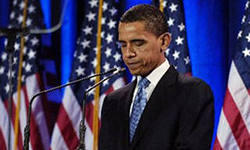
The President was originally intended to be little more than a ceremonial Head of State, as well as Commander-in-Chief of the armed forces, but the Federal Government's increasing involvement in the Nation's economic life and its prominent role in international affairs, where secrecy and speed are often essential, has increased the importance of the Presidency over Congress.
The President now proposes a full legislative program to Congress, although the President, the Cabinet and staff are not, and cannot be, members of Congress. This means that the various bills must be introduced into the House of Representatives or Senate by their members. The President is consequently completely powerless when faced by an uncooperative Congress. Given also the difficulties in ensuring that the laws passed are effectively implemented by the federal bureaucracy, it has been said that the President's only real power is the power to persuade.
The President is assisted by the members of the Cabinet who administer 11 major departments: State, Defense, Justice, Treasury, Commerce, Labor, Health, Education and Welfare, Housing and Urban Development, Interior, Agriculture and Transportation. Though they rank as the President's chief advisers, in recent decades members of President's administration have generally more influence on him.
The role of the Vice President is not very well defined by the Constitution, which gives him or her no other task than presiding over the debates in the Senate, where he may only vote in the case of a tie. Yet the Vice President takes over from the President in case of death, resignation, or sickness, which has already happened on eight occasions. To try and attract able men to this otherwise unimportant, mainly ceremonial post, Vice Presidents have recently been given more important tasks, especially in foreign affairs.
The residence of the Administration is the White House.
Inaugurations of Presidents and Vice Presidents take place on January 20 of every year following a national election. These ceremonies are held on a platform erected over the great steps on the East front of the Capitol Building. The oath of office is administered by the Chief Justice of the United States.
________________3__________________
The symbol of government is the white marble dome of the Capitol which dominates the city of Washington, D. С The building has grown with the country: although George Washington laid the cornerstone in 1793, the dome was not finished until 1863, and many changes have since been made. Home to both House and Senate, the Capitol was once hailed as "the center and heart of America".
Congress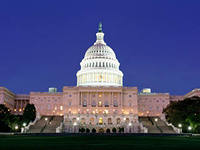
The legislative branch of national government, Congress, consists of two houses — the Senate and the House of Representatives, each with a different role, different powers and a different electoral procedure.
The two branches of Congress are responsible for enacting the nation's laws. Though these days most major bills originate in the White House, all must be approved, disapproved, or amended by both Houses, and no measure becomes law until it has been passed by a majority in each House. The President may then sign of veto the bill, but a two-thirds vote in each House can override a veto.
Although Congress can legislate, its most important task has become that of scrutinizing the policies and actions of the executive, and upholding the interests of States and districts. Indeed, since Representatives and Senators depend on the voters in their various States or constituencies for re-election, they tend to satisfy the particular interests of constituents and special groups rather than tackle the problems of the nation as a whole. Congress also controls the nation's finances and its permanent specialist staff helps Congress to consider and change the budget presented each year by the President.
The House of Representatives
The House of Representatives is the dynamic institution of the federal government. The States are represented on a population basis and are divided into congressional districts or constituencies of roughly equal size (around 520,000 people). There are currently 435 members, who are elected every two years. All States must by law adopt the system of single-member constituencies with a simple majority vote. Vacancies arising from death, resignation, etc., are filled by by-elections.
The chairmen of the House of Representatives, the Speaker, is elected by the House and has important responsibilities, giving him considerable influence over the President. Moreover, should the President and Vice President die before the end of their terms, it is the Speaker who becomes President.
The Senate
The Senate is the conservative counterweight to the more populist House of Representatives. Each State has two senators who, since 1913 (the Seventeenth Amendment) have been chosen directly by the electorate in the way decided by the state legislature in each state. Senators are elected every six years, but the elections are staggered so that one-third of the Senate is elected every two years. A vacancy caused by death or resignation is filled until the next congressional elections by the nomination of the State Governor. There are currently 100 senators. The Senate has the special privilege of unlimited debate to safeguard the rights of minorities, but this can enable a small group of Senators to prevent the passage of a bill (filibustering).
_______________4_________________
The Supreme Court stands at the apex of the Nation's Federal Judiciary system and hears cases on appeal from lower courts — the Federal District Courts and the US Courts of Appeals.
There are eight Associate Justices and the Chief Justice in the Supreme Court, and Congress may alter this number. All these High Court judges are nominated for life by the President after being approved by the Senate.
Though the primary function of the Supreme Court is to decide matters of law, rather than fact, the High Court's power to declare acts of the President, Congress, State legislatures, and city councils unconstitutional can drastically alter the nation's practices, as when the Supreme Court branded school segregation unconstitutional in 1954. So, although not explicitly given the power to decide whether the actions of the branches of government violate the Constitution, this is the important role that the Supreme Court has developed in the legal system.
In the federal system there are 90 District Courts (presided over by a district judge), which hear criminal cases involving breaches of federal law and civil cases on federal matters (disputes between States, non-payment of federal taxes, etc.).
Appeals can be made to the United States Court of Appeals, where an appeal is heard by three judges, although in very important cases all nine appeal judges sit together. In the vast majority of cases this court's decision is final and sets a precedent for future cases, although this precedent is not always binding on the Supreme Court.
____________________5____________________
State Government
There is very little in the Constitution about State government — the Tenth Amendment (1791) merely says that those powers not specially delegated to the federal government are reserved for States. While the fifty State constitutions differ widely, they all include the separation of powers and a system of checks and balances, and share the underlying American belief that government should be kept to a minimum.
Each State has a Governor, a Legislature and a State Judiciary. This means that each State parallels the governmental forms of the Federal system.
The Governor is elected directly in a state-wide election. All the states except Nebraska have bicameral legislatures, normally called the Senate and House of Representatives.
The judicial systems of the States vary greatly in structure and procedures. Generally speaking, however, at the lowest level there are Courts, which deal with the majority of civil and criminal cases. Appeals go to the District Court of Appeals, while the State Supreme Court has the same role as the United States Supreme Court in the federal system.
All States have the right to levy taxes; and many services — such as education, health, welfare, and police — are supported either entirely or in large measure by State, rather than Federal, funds. The sovereignty of State governments has, however, been steadily eroded. Functions such as education, unemployment relief, public works, and the like — once considered entirely within State jurisdiction — are now matters of Federal concern as well.
County and City Governments
These governments are solely the creations of the States, and the powers of such jurisdictions vary greatly from one State to the next. In Connecticut, for example, there are no county governments, while next door in New York, some counties, such as Nassau, have significant powers of taxation.
The same is true for city governments, all of which derive their powers from the States. In some States the power of city governments to tax, to educate, and to operate broad-scale social services is great, while in other States the cities are virtually impotent in many areas. But, as befits American system, the balance can always be shifted.
The land
Read the text below. For questions (1-5) choose the correct answer (A, B, C, D).
THE COUNTRY
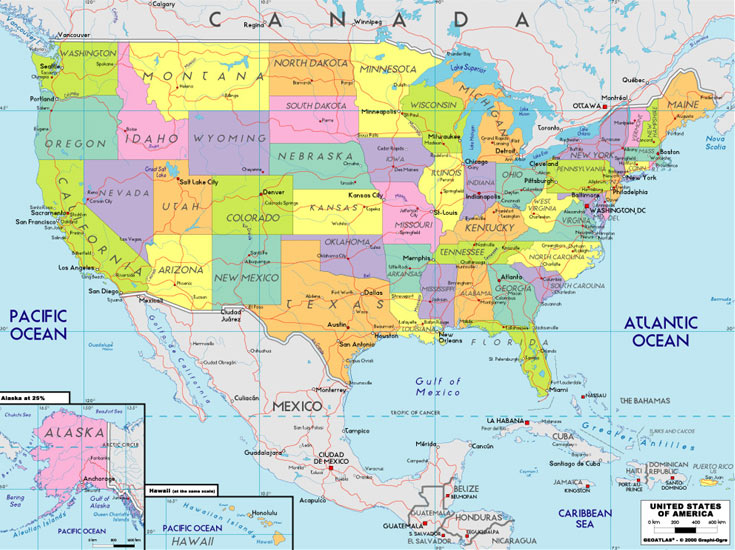
The United States of America has an area of 3,615,122 square miles (9,4 mln square kilometers) almost all of which is on the American continent. Its overseas possessions are mainly small Pacific Islands (Guam, Samoa, etc.) plus Puerto Rico. There are 50 states and one Federal District, created as a site for the Federal Capital, Washington, and known as the District of Columbia.
The USA is considered to be the fourth largest country in the world. The 48 conterminous states extend from latitude 25° N to 50° N and longitude 125° W to 67° W. From New York in the East to San Francisco or Los Angeles in the West, i.e. from the Atlantic coast to the Pacific coast, you have to travel more than 4,500 km and leave behind four time zones. The other two states, Alaska and Hawaii, are situated respectively near the Arctic circle and in the tropical part of the Pacific Ocean (3,200 km from the mainland).
Thanks to these geographical extremes, different parts of the country range from moist rain forest areas to arid desert regions and bald mountain peaks. Mount McKinley in Alaska of 20,320 feet (6,194 meters) above sea level is the highest point in the USA, while part of Death Valley in California is 282 feet (89 meters) below sea level. The West is an extensive mountain area occupying approximately one-third of the United States and is a region of tremendous variety, which can be subdivided into various other areas. It consists of high ranges of the Cordillera parallel to the Pacific Coast culminating on its eastern border in the Rocky Mountains (a high, discontinuous chain of mountains with peaks of 13,000 and 14,000 feet), which, in their turn, stretch from mountainous Alaska down to Mexico. These mountains are rich in resources such as gold, lead and uranium.
Among high mountains at the western edge of the Cordillera — the Sierra Nevada, the Cascades and the Coastal Ranges — there are broad, fertile valleys and large plateau regions with canyons, cliffs and basins that contain many important metals, oil and natural gas.
The heart of the United States is a vast plain, which extends from Central Canada southwards to Mexico and from the Cordillera eastwards to the Appalachian Mountains. These interior plains, which rise gradually like a saucer to higher land on all sides, are divided into two major parts: the eastern portion is called the Central Plains and the western portion — the Great Plains, both of which have good soil.
The Appalachian Mountains — a chain of low, almost unbroken mountains — are extremely rich in coal and iron. These mountains are at the western edge of the Atlantic coastal plain, which is a long, gently rolling lowland area. These coastal plains are very flat: nowhere in Florida, for example, is more than 350 feet above sea level. The soil is very poor, except in the fertile southern part — the Cotton Belt of the Old South and the citrus country of Central Florida.
Hawaii is a chain of twenty islands, only seven of which are inhabited. The mountainous islands were formed by volcanic activity and there are still a number of active volcanoes.
1. What is mentioned in the text about the territory of the USA?
A The USA is considered to be the third largest country in the world.
B The USA is considered to be the fourth largest country in the world.
C The USA is considered to be the second largest country in the world.
D The USA is considered to be the fifth largest country in the world.
2. What part of the USA is an extensive mountain area?
A The South is an extensive mountain area occupying approximately one-third of the United States.
B The North is an extensive mountain area occupying approximately one-third of the United States.
C The East is an extensive mountain area occupying approximately one-third of the United States.
D The West is an extensive mountain area occupying approximately one-third of the United States.
3. What is the heart of the USA and where is it situated?
A The heart of the United States is a vast plain, which extends from Central Canada southwards to Mexico and from the Cordillera eastwards to the Appalachian Mountains.
B The heart of the United States is a vast plain, which extends from northern Canada southwards to Mexico and from the Cordillera eastwards to the Appalachian Mountains.
C The heart of the United States is a vast plain, which extends from southern Canada southwards to Mexico and from the Cordillera eastwards to the Appalachian Mountains.
D The heart of the United States is a vast forest, which extends from Central Canada southwards to Mexico and from the Cordillera eastwards to the Appalachian Mountains.
4. What are the Appalachian Mountains rich in?
A The Appalachian Mountains — a chain of low, almost unbroken mountains — are extremely rich in coal and ore.
B The Appalachian Mountains — a chain of low, almost unbroken mountains — are extremely rich in coal and oil.
C The Appalachian Mountains — a chain of low, almost unbroken mountains — are extremely rich in coal and iron.
D The Appalachian Mountains — a chain of low, almost unbroken mountains — are extremely rich in oil and iron.
5. How many of Hawaii islands are inhabited?
A Hawaii is a chain of twenty islands, only six of which are inhabited.
B Hawaii is a chain of twenty islands, only seven of which are inhabited.
C Hawaii is a chain of twenty islands, only eight of which are inhabited.
D Hawaii is a chain of twenty islands, only nine of which are inhabited.
Read the texts below. Match the headings (A-J) to (1-9). There is a choice you don’t need to use.
A THE FAR WEST: CALIFORNIA
B NATURAL RESOURCES
C THE CENTRAL NORTHWEST: COLORADO
D THE SOUTH: NEBRASKA
E THE SOUTHWEST: ARIZONA
F THE SOUTH: FLORIDA
G WEATHER AND CLIMATE
H THE NORTHEAST: MASSACHUSETTS
I THE SOUTHWEST: TEXAS
J NATIONAL PARKS
_________________1_____________________
Virtually every type of climate can be found somewhere in the United States — from arctic in Alaska to subtropical in Florida. The climate is not generally temperate, despite the latitude, because the tremendous size of the North American land mass heightens the extreme variations in temperature and precipitation, especially in the central regions (in Dakota temperatures have reached a maximum of 49 °C and a minimum of -60 °C).
Most of the country has a humid continental climate with hot summers and cold winters, while the lack of natural barriers either to the north or south allows cold, dry air to flow south from Canada and warm, humid air north from the Gulf of Mexico, giving rise to spectacular weather of every possible type in the Great Plains and Midwest. Summers are hot and very humid in this region and rainfall decreases to the west as a result of the rain shadow created by the West Pacific Range and the Sierra Nevada. The southwest portion of the Great Plains is the hottest and most arid region of the United States, with precipitation, mostly in the form of summer showers, averaging less than 250 mm a year.
The Pacific coast is almost rainless in the summer, although there is often fog. In winter there is frequent drizzle, but the climate remains generally warm and dry, especially in California.
The eastern part of the country is moderately rainy, with the precipitation fairly well distributed throughout the year. Summers tend to be extremely humid, especially along the coast of Texas and Florida.
_______________2_________________
The United States possesses vast non-fuel natural resources. The major resource is iron, three quarters of which comes from the Lake Superior region of the Great Lakes. Other basic metals and minerals mined on a large scale are zinc, copper, silver and phosphate rock (used for fertilizers). This wealth is distributed throughout most of the country, but Texas and the West (especially California) are the most important mineral-producing areas. Mining and quarrying account for only about 2 % of GNP.
The United States produces one quarter of the world's coal and one seventh of its petroleum, with sufficient coal reserves to last for hundreds of years. About half of the nation's electric power comes from coal-fired power stations, while natural and manufactured gas supply more than 33 % of the nation's power. The main gas fields are found near the main oil fields in Texas, Louisiana and Alaska. Nuclear power is also used in many places, using uranium mined in New Mexico and Wyoming, and produces over 10 % of the nation's energy output.
___________________3______________________
No nation had ever done anything like that. Indeed, the very idea of the Federal Government's setting aside a portion of the public domain in the Rocky Mountains for use as a national "pleasuring ground" instead of for private exploitation by farmers, ranchers, or miners had a faintly improper ring, particularly in the "robber baron" era of unbridled private enterprise following the Civil War.
Nevertheless, depictions by artists and photographers, and the reports of official survey teams all pointed to one inevitable conclusion: that the Yellowstone region of the Rockies was of such exceptional beauty, such awe-aspiring dimensions, that this sublime gift of nature was a national treasure, far too valuable for private development, and that it must belong in perpetuity to the entire American people.
Accordingly, Congress passed and President Grant signed legislation establishing Yellowstone National Park, which over the years has been extended to take in 2.2 million acres of breathtakingly beautiful country in Idaho, Montana, and — mainly — Wyoming.
Yellowstone became the first reserve of its kind in the world and the model for US national park system.
Almost two decades passed before new national parks were created, and then, in 1890, Sequoia and Yosemite were both established in California. Subsequently, the pace quickened, particularly during Theodore Roosevelt's conservation-minded administration (1901-1909), when eight new national parks were established.
Today there are 38 national parks, most of them in the West, covering more than 14 million acres. Additional millions of acres have been set aside as national monuments, national recreation areas, national forests and national seashores. Within those sanctuaries millions of vacationing Americans each year enjoy days or weeks of relaxation amid nature's most impressive splendours — preserved by man for posterity.
___________________4_________________________
It is one of New England States with a coastline on the Atlantic. The interior is hilly, rising to over 30,000 feet. The Merrimack and Connecticut are the chief rivers.
Boston is the capital and largest city.
The State became one of the original 13 States. Almost everyone knows at least a little about the early days of Massachusetts. The names of Plymouth, Boston, Cape Cod, Salem, Concord and Lexington are also familiar. Plymouth is the very place where the Pilgrim Fathers on board the "Mayflower" landed in 1620 to found the Plymouth Colony. It is in Lexington that the American Revolution began. This town is matched historically with its Revolutionary twin, Concord. The "shot heard round the world" was fired in Concord.
From earliest colonial days, the Massachusetts men were fishermen. Fish, lobsters, and clams certainly saved some of the settlers from starvation. Fishing is still a big industry. Until the middle of the 19th century Massachusetts sent whaling vessels on voyages to the Pacific Ocean.
Part of Massachusetts is a good farming country. The Connecticut Valley produces general crops, including potatoes, but its successful tobacco farms are more famous. One of the best known specialities of the State is its cranberry crop, grown at the landward end of the Cape Cod.
Early Massachusetts was well forested, and every port had a shipyard where fishing boats were built, and also wooden trading vessels which were sailed by the Massachusetts men to the ports of Europe, Asia and Africa, and to domestic ports farther south on the Atlantic coast. The traders brought back raw materials that gave Massachusetts an early start in manufacturing.
Cotton from the South was the basis of the textile industry in which Massachusetts was a leader until the 20th century. Then the South became the center of cotton manufacture but Massachusetts still has many textile mills, as well as a wide variety of other manufacturing industries.
Now Massachusetts is a highly industrial State. Electrical machinery, including electronics and communications equipment, has become the State's leading product.
Massachusetts has many famous universities and colleges. Across the Charles River, close to Boston, stands Cambridge, where the cultural history of America has developed side by side with the history of Harvard University (the country's oldest). Named after John Harvard, a clergyman, who at his death in 1638 left the institution a few hundred books and half his estate, Harvard has turned into one of the largest, richest, and best universities in the world.
___________________5_______________________
The State is completely different from all other southern States. It consists mainly of a peninsula between the Atlantic Ocean and the Gulf of Mexico. The entire State is flat, with only a very few hills in the interior. In the south there is a swampy region.
Agriculture is the chief industry, and sugar, псе, cotton, tobacco and tropical fruits are grown. Fishing is important, and there are valuable forest reserves. Cattle raising is gaining importance.
Florida was chosen by NASA as a perfect launching place. At Cape Kennedy, formerly Canaveral, is the US Missile Test Center from which satellites are sent into manned space and orbital flights.
Although an agricultural State by geography, inclination and climate, it has been developed primarily as a resort area. The shorelines are sandy, with miles of fine white bathing beaches. So the State's leading business activity is tourism.
Tallahassee is the capital but Jacksonville and Tampa are larger. Miami is a famous resort on the southeast coast. Other resort towns are Palm Beach, Key West, Venice.
Florida was discovered in 1513 and was bought by the USA from Spain in 1819, becoming a State in 1849.
_________________6_____________________
It is the largest and most southern state on the Mexican border with a coastline on the Gulf of Mexico. The chief rivers are the Rio Grande and the Colorado. Much of the central part of the State is flat prairie land.
Cattle raising and poultry are major activities. Texas is also an important agricultural state. Agriculture products include cotton, corn, vegetables, grains, and cereals. Minerals include petroleum and cement. The State's leading manufactures are chemicals, oil and gas, wood products and leather.
Austin is the capital, but Houston, Dallas and San Antonio are much larger. The Capitol at Austin, built in 1888 of red granite, covers three acres and is 311 feet to the top of its dome; it is the largest of the States' Capitols.
There are more than 600 airports in Texas, including about 60 major US Air Force bases.
Texas has more than 130 higher educational institutions, the most famous being the University of Texas at Austin.
Texas became independent in 1836, and entered the Union in 1846. Texas is the only State that was an independent republic recognized by the United States before annexation.
_________________7_____________________
Colorado is the State in the Rocky Mountains. Being the highest State in the country, it contains some of the highest peaks as well. All in all, there are 52 peaks over 14,000 feet in elevation. Numerous rivers rise in the mountains, the chief being the Colorado and the Arkansas.
Coal, gold, silver, copper, lead and petroleum are mined. Agriculture is becoming important, sugar-beet, wheat, maize and oats being the chief crops.
There are several National Parks. Denver is the capital and largest town; others are Pueblo and Colorado Springs.
Colorado became a State in 1876.
_______________8_________________
The natural features of this State are the Colorado River with its extensive deserts and famous canyons among which is the world known Grand Canyon.
The soil is not fertile; cattle and sheep are reared, but the chief products are minerals.
Phoenix is the capital.
The Grand Canyon of Arizona has sometimes been called the greatest of the world's wonders. It is, in fact, the world's most spectacular illustration of erosion, being the result of the combined action of a great river, of rain, wind and of frost.
The Grand Canyon is a gigantic chasm, 247 miles long, 4 to 14 miles wide and 1 mile deep. At the bottom is the mighty Colorado River that rushes to the sea and carries an average of nearly half a million tons of silt through the Canyon every day. Rising from the depths of the Canyon are ranges of mountains.
According to geologists' estimates, it has taken 7 to 9 million years to cut the Grand Canyon. Rocks from the first era of geological history are exposed on the Canyon's walls. More than 6,000 prehistoric sites have been found in Grand Canyon National Park.
The colors of the Canyon change through the day. One cannot describe its beauty, and the Grand Canyon is always mysterious.
________________9__________________
This State lies north of the Mexican border and has a long Pacific coastline. Except for the south, where there is the California Desert, there are three distinct geographical divisions: the Sierra Nevada, which runs the length of the state and rises to 14,500 feet in Mount Whitney; the Coast Range, a series of ranges; and the great California Valley, containing the Sacramento and San-Joaquin rivers, which unite and flow through the Golden Gate into San Francisco Bay.
Gold, silver, copper, lead and petroleum are produced. The film industry is important.
Sacramento is the geographical capital, but Los Angeles and San Francisco are very important. Los Angeles is the motion picture capital, with major studios in Hollywood, and San Francisco is the biggest Pacific Coast port, a major banking, communications, financial, and industrial center.
California was part of Mexico from its discovery until 1846, when it was claimed by the USA. It became a State in 1850, following the increase in population and property caused by the "gold rash" of 1849.
California is nicknamed the Golden State. The emblem of the State is a golden poppy, and the entrance to its finest harbor is called the Golden Gate. The glamour of Hollywood, a romantic past, snow-topped mountains, rushing streams, the sparkling blue Pacific, mysterious deserts, warm winters — all these make California very attractive for the people who dream of it.
California has about 200 higher educational institutions. Among the world famous are the University of California, Stanford University, University of Southern California, and California Institute of Technology.
American school system
Read the texts below. Choose from (A-H) the one which best fits each space (1-7). There is a choice you don’t need to use
Education is not mentioned in the Constitution, nor is there any federal department of education, so the matter is left to individual States. Education is free and_____1_______, however, from the age of 6 till 16 or 18. So, most American children go to State schools. In the USA these are called public schools. There are also some private schools, which are usually supported by religious organizations.
At 6 years of age children begin the first year of elementary school, which is called "Grade 1" or "First Grade" (the second year is "Grade 2", etc.). At elementary school the emphasis is placed on the basic skills — speaking, reading, writing and arithmetic, though the general principle throughout the American school system is that children should be helped and encouraged to develop their own particular interests.
Children move on to high school in the seventh grade, where they continue until the twelfth grade. There are two basic types_____2_____: one with a more academic curriculum, preparing students for admission to college, and the other offering primarily vocational education (training in a skill or trade). The local school board decides which courses are compulsory. There is great freedom of choice, however, and an important figure in high schools is the guidance counselor, who advises the students on what courses to take on the basis of their career choices.
There are no national exams, although some schools and States have their own exams. Generally examination is given by continuous assessment, which means that teachers assess children throughout the year on how well they do in tests, classroom discussions and_____3________.
In order to receive the high school diploma necessary in most States to get into college, students must accumulate a minimum number of credits, which are awarded for the successful completion of each one- or half-year course. Students hoping to be admitted to the more famous universities require far more than the minimum number of credits and must also have good grades (the mark given on the basis of a course work and a written examination). Some colleges and universities require the students to take the SAT (Scholastic Aptitude Test).
Extra-curricular activity (such as playing for one of the school's sports teams) is also ______4______in the American school system and is taken into consideration by colleges and employers.
HIGHER EDUCATION
There are about 3,000 colleges and universities, both private and public, in the United States. Students have to pay to go to both private and State universities. Private universities are generally smaller but very expensive, which means that the tuition fees are extremely high. State colleges and universities are not that expensive, the tuition fees are usually lower, and if the students are State residents,_______5_________.
Every young person who enters a higher educational institution can get financial assistance. If a student is offered a loan, he should repay it (with interest) after he has left the college. Needy students are awarded grants which they do not have to repay. Scholarships are given when a student is doing exceptionally well at school.
American universities and colleges are usually built as a separate complex, called "campus", with teaching blocks, libraries, dormitories, and many other facilities grouped together on one site, often on the outskirts of the city. Some universities are comprised of many campuses. The University of California, for example, has 9 campuses, the biggest being Berkeley (founded in 1868), San Francisco (1873), Los Angeles (1919), Santa Barbara (1944), Santa Cruz (1965).
All the universities are independent, offering their own choice of studies, setting their own admission standards and deciding which students meet those standards. The greater the prestige of the university, the higher the credits and grades required.
The terms "college" and "university" are often used interchangeably, as "college" is used to refer to all undergraduate education; and the four-year undergraduate program, leading to a bachelor's 3 degree, can be followed at either college or university. Universities ______6_______than colleges and also have graduate schools where students can receive post-graduate education. Advanced or graduate university degrees include law and medicine.
Most college and university undergraduate courses last for four years. During the first two years students usually follow general courses in the arts or sciences and then choose a major — the subject or area of studies in which they concentrate. The other subjects are called minors. Credits (with grades) are awarded for the successful completion of each course. These credits are often transferable, so students who have not done well in high school can choose a junior college (of community college), which offers a two-year "transfer" program,' preparing students for degree-granting institutions. Community colleges also offer two-year courses of a vocational nature, leading to technical and semi-professional occupations, such as journalism.
There are no final examinations at colleges and universities, and students receive a degree if they _____7______enough credits in a particular subject. The traditional degree which crowns the undergraduate course is that of a Bachelor of Arts (B. A.) or a Bachelor of Science (B. S.). The lower level of graduate school is for obtaining the Master's Degree (M. A. or M. S.), and the upper level is for the degree of Ph.D.
A very important
B compulsory in all States
C written and oral work
D tend to be larger
E have collected
F of high school
G has sometimes been called
H they pay much less
Висновок
Даний збірник матеріалів сприяє формуванню мотивації читання – розуміння учнями його корисності та необхідності, почуття задоволеності, яке дає сам процес читання чи досягнення мети читання – отримання інформації. Тести можуть використовуватися як на уроках англійської мови, так і під час самостійної роботи учнів вдома.
Використані джерела
1. http://lengish.com/texts/category-4.html
2. www.govorimpro.us/изучение-английского-языка/12852-english-usa.html1


про публікацію авторської розробки
Додати розробку

